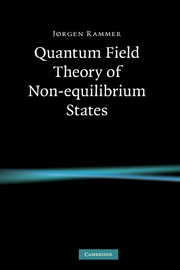Book contents
- Frontmatter
- Contents
- Preface
- 1 Quantum fields
- 2 Operators on the multi-particle state space
- 3 Quantum dynamics and Green's functions
- 4 Non-equilibrium theory
- 5 Real-time formalism
- 6 Linear response theory
- 7 Quantum kinetic equations
- 8 Non-equilibrium superconductivity
- 9 Diagrammatics and generating functionals
- 10 Effective action
- 11 Disordered conductors
- 12 Classical statistical dynamics
- Appendices
- Bibliography
- Index
8 - Non-equilibrium superconductivity
Published online by Cambridge University Press: 24 December 2009
- Frontmatter
- Contents
- Preface
- 1 Quantum fields
- 2 Operators on the multi-particle state space
- 3 Quantum dynamics and Green's functions
- 4 Non-equilibrium theory
- 5 Real-time formalism
- 6 Linear response theory
- 7 Quantum kinetic equations
- 8 Non-equilibrium superconductivity
- 9 Diagrammatics and generating functionals
- 10 Effective action
- 11 Disordered conductors
- 12 Classical statistical dynamics
- Appendices
- Bibliography
- Index
Summary
Superconductivity was discovered in 1911 by H. Kamerlingh Onnes. Having succeeded in liquefying helium, transition temperature 4.2K, this achievement in cryogenic technology was used to cool mercury to the man-made temperature that at that time was closest to absolute zero. He reported the observation that mercury at 4.2K abruptly entered a new state of matter where the electrical resistance becomes vanishingly small. This extraordinary phenomenon, coined superconductivity, eluted a microscopic understanding until the theory of Bardeen, Cooper and Schrieffer in 1957 (BCS-theory). The mechanism responsible for the phase transition from the normal state to the superconducting state at a certain critical temperature is that an effective attractive interaction between electrons makes the normal ground state unstable. As far as conventional or low-temperature superconductors are concerned, the attraction between electrons follows from the form of the phonon propagator, Eq. (5.45), viz. that the electron–phonon interaction is attractive for frequencies less than the Debye frequency, and in fact can overpower the screened Coulomb repulsion between electrons, leading to an effective attractive interaction between electrons. The original BCS-theory was based on a bold ingenious guess of an approximate ground state wave function and its low-energy excitations describing the essentials of the superconducting state. Later the diagrammatic Green's function technique was shown to be useful to describe more generally the properties of superconductors, such as under conditions of spatially varying magnetic fields and especially for general non-equilibrium conditions.
- Type
- Chapter
- Information
- Quantum Field Theory of Non-equilibrium States , pp. 217 - 252Publisher: Cambridge University PressPrint publication year: 2007



